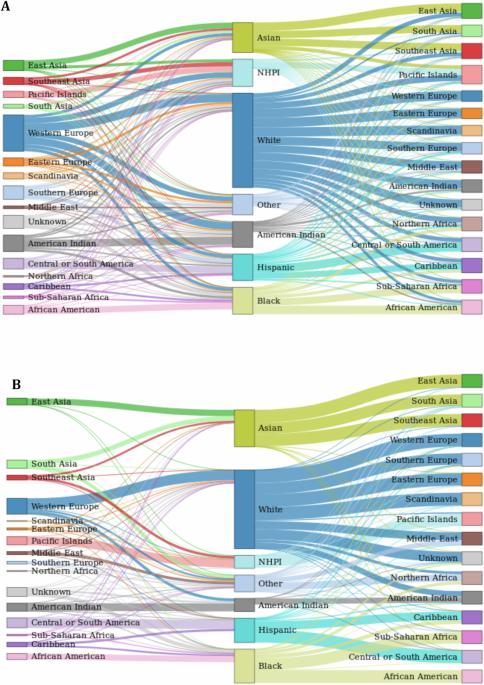Multiple measures for self-identification improve matching donors with patients in unrelated hematopoietic stem cell transplant
IF 5.4
Q1 MEDICINE, RESEARCH & EXPERIMENTAL
引用次数: 0
Abstract
Questions persist around whether and how to use race or geographic ancestry in biomedical research and medicine, but these forms of self-identification serve as a critical tool to inform matching algorithms for human leukocyte antigen (HLA) of varying levels of resolution for unrelated hematopoietic stem cell transplant in large donor registries. Here, we examined multiple self-reported measures of race and ancestry from a survey of a cohort of over 100,000 U.S. volunteer bone marrow donors alongside their high-resolution HLA genotype data. We find that these self-report measures are often non-overlapping, and that no single self-reported measure alone provides a better fit to HLA genetic ancestry than a combination including both race and geographic ancestry. We also found that patterns of reporting for race and ancestry appear to be influenced by participation in direct-to-consumer genetic ancestry testing. While these data are not used directly in matching for transplant, our results demonstrate that there is a place for the language of both race and geographic ancestry in the critical process of facilitating accurate prediction of HLA in the donor registry context. Self-identification with respect to race and ancestry is an important component in the process of finding a matching unrelated bone marrow donor for a patient in large donor registries. Here, we considered whether terms specific to either race or the geographic ancestry of donors would be more useful in the matching process. We found that rather than using either of these terms alone, collecting responses for both race and geographic ancestry from potential donors is most likely to provide the information necessary to find a genetic match among millions of donors for a patient in need of a transplant. Damotte et al. examine the utility of multiple measures of race and ancestry self-identification in the context of matching HLA for potential unrelated bone marrow donors with patients. They show that combining both race and geographic ancestry provides a better fit to HLA than either measure alone.

多重自我身份识别措施改善了非亲缘造血干细胞移植中捐赠者与患者的匹配情况
是否以及如何在生物医学研究和医学中使用种族或地理血统的问题一直存在,但这些形式的自我认同是一种重要工具,可为大型捐献者登记处中不同分辨率的人类白细胞抗原(HLA)匹配算法提供信息,用于非亲属造血干细胞移植。在此,我们对超过 10 万名美国自愿骨髓捐献者进行了调查,并对他们的高分辨率 HLA 基因型数据进行了研究。我们发现,这些自我报告的衡量标准往往是不重叠的,而且没有任何一种自我报告的衡量标准能比包括种族和地域血统的组合更适合 HLA 遗传血统。我们还发现,种族和祖先的报告模式似乎会受到参与直接面向消费者的基因祖先检测的影响。虽然这些数据并不直接用于移植配型,但我们的研究结果表明,在捐献者登记处准确预测 HLA 的关键过程中,种族和地理血统语言都有其存在的价值。在大型捐献者登记处为患者寻找匹配的非亲属骨髓捐献者的过程中,种族和血统的自我认同是一个重要的组成部分。在此,我们考虑了在匹配过程中,特定于捐献者种族或地域血统的术语是否会更有用。我们发现,收集潜在捐献者对种族和地域血统的回答比单独使用其中一个术语更有可能提供必要的信息,从而在数百万捐献者中为需要移植的患者找到基因匹配的捐献者。Damotte 等人研究了潜在非亲属骨髓捐献者与患者 HLA 匹配时,种族和祖先自我认同的多种措施的效用。他们的研究表明,将种族和地域血统结合起来比单独使用其中一种方法更能与 HLA 匹配。
本文章由计算机程序翻译,如有差异,请以英文原文为准。
求助全文
约1分钟内获得全文
求助全文

 求助内容:
求助内容: 应助结果提醒方式:
应助结果提醒方式:


